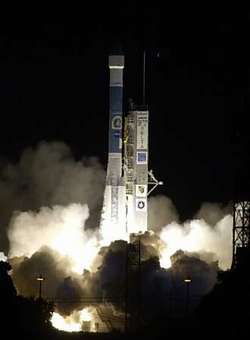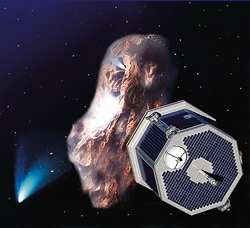Thu, Jul 04, 2002
NASA Mission on Course to Provide Unparalleled Look at
Comets
 NASA’s Comet Nucleus Tour (CONTOUR)
spacecraft – set to provide the closest look yet at the
“heart” of a comet–successfully launched
Wednesday at 2:47 a.m. EDT aboard a Boeing Delta II rocket from
Cape Canaveral Air Force Station (FL).
NASA’s Comet Nucleus Tour (CONTOUR)
spacecraft – set to provide the closest look yet at the
“heart” of a comet–successfully launched
Wednesday at 2:47 a.m. EDT aboard a Boeing Delta II rocket from
Cape Canaveral Air Force Station (FL).
Designed and built by The Johns Hopkins University Applied
Physics Laboratory (APL) in Laurel (MD), the 2,138-pound
(970-kilogram) spacecraft was placed into an elliptical Earth orbit
63 minutes after launch. About 19 minutes later, the mission
operations team at APL acquired a signal from the spacecraft
through the Deep Space Network antenna station in Goldstone(CA),
and by 5:45 a.m. EDT Mission Director Dr. Robert W. Farquhar of the
Applied Physics Lab confirmed the craft was operating normally and
ready to carry out its early orbit maneuvers.
“CONTOUR’s launch was a spectacular start to an
important project,” says Dr. Stamatios M. Krimigis, head of
the APL Space Department. “CONTOUR is next in the growing
lineup of missions to explore small planetary bodies – such
as comets and asteroids – and we expect it will add much to
what little we know about these ancient samples of the solar
system’s original materials.”
Running Around in Circles for a While...
CONTOUR will orbit Earth until August 15, when it’s
scheduled to fire its main engine and enter a comet-chasing orbit
around the sun. The mission’s flexible four-year plan
includes encounters with comets Encke (Nov. 12, 2003) and
Schwassmann-Wachmann 3 (June 19, 2006), though it can add an
encounter with a “new” and scientifically valuable
comet from the outer solar system, should one be discovered in time
for CONTOUR to fly past it. CONTOUR’s four scientific
instruments will take detailed pictures and measure the chemical
makeup of each comet’s nucleus – a chunk of ice and
rock – while analyzing the surrounding gas and
dust.
Wearing a Bulletproof Vest
 The 8-sided solar-powered craft will fly as close
as 62 miles (100 kilometers) from each nucleus, protected by a
10-inch-thick, layered dust shield of heavy Nextel and Kevlar
fabric. Scientists expect the data to reveal the differences
between comet nuclei and answer questions about the role comets had
in shaping the Earth and other planets.
The 8-sided solar-powered craft will fly as close
as 62 miles (100 kilometers) from each nucleus, protected by a
10-inch-thick, layered dust shield of heavy Nextel and Kevlar
fabric. Scientists expect the data to reveal the differences
between comet nuclei and answer questions about the role comets had
in shaping the Earth and other planets.
“We’re looking forward to a fantastic mission,”
says APL’s Edward L. Reynolds, who at launch assumed the role
of CONTOUR project manager from Mary C. Chiu, who is retiring from
the Applied Physics Laboratory. “From mission design and
operations at APL, to the navigation group at NASA’s Jet
Propulsion Laboratory, to the science effort headed by Cornell
University, this team includes the talent and expertise needed to
capture and deliver the best data yet on a comet’s
nucleus.”
The $159 million CONTOUR is the sixth mission in NASA’s
Discovery Program of lower cost, scientifically focused exploration
projects.
More News
Aero Linx: Transport Canada We are a federal institution, leading the Transport Canada portfolio and working with our partners. Transport Canada is responsible for transportation p>[...]
Gross Navigation Error (GNE) A lateral deviation from a cleared track, normally in excess of 25 Nautical Miles (NM). More stringent standards (for example, 10NM in some parts of th>[...]
From AirVenture 2017 (YouTube Edition): Flight-Proven Booster On Display At AirVenture… EAA AirVenture Oshkosh is known primarily as a celebration of experimental and amateu>[...]
Aircraft Parachute System (CAPS) Was Deployed About 293 Ft Above Ground Level, Which Was Too Low To Allow For Full Deployment Of The Parachute System Analysis: The day before the a>[...]
Also: 48th Annual Air Race Classic, Hot Air Balloon Fire, FAA v Banning 100LL, Complete Remote Pilot The news Piper PA-18 Super Cub owners have been waiting for has finally arrived>[...]
 ANN's Daily Aero-Linx (06.29.25)
ANN's Daily Aero-Linx (06.29.25) ANN's Daily Aero-Term (06.29.25): Gross Navigation Error (GNE)
ANN's Daily Aero-Term (06.29.25): Gross Navigation Error (GNE) Classic Aero-TV: Anticipating Futurespace - Blue Origin Visits Airventure 2017
Classic Aero-TV: Anticipating Futurespace - Blue Origin Visits Airventure 2017 NTSB Final Report: Cirrus SR22
NTSB Final Report: Cirrus SR22 Airborne Affordable Flyers 06.26.25: PA18 Upgrades, Delta Force, Rhinebeck
Airborne Affordable Flyers 06.26.25: PA18 Upgrades, Delta Force, Rhinebeck




